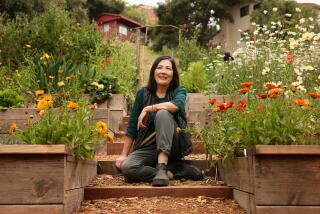Gardening : The Greening of a Trophy Room : Starting With Just One Plant 6 Years Ago, Jim Boehme of Anaheim Has Seen His Collection of Staghorn Ferns Grow Into the Thousands
- Share via
Jim Boehme proudly displays his trophies throughout his Anaheim patio and garden. Mounted on redwood, each bearing an identification plaque, the vivid green, antler-like trophies are a tribute to his skills, not in marksmanship but in horticulture.
For the past six years, Boehme has grown Platycerium, better known as staghorn ferns. He started with one mature plant purchased at the San Diego Wild Animal Park in Escondido. Now, his back yard is dominated by a 40-foot-square greenhouse, where nearly every inch is filled with young Platycerium plants, perhaps 4,000 in all.
“They’re such interesting-looking plants that I wanted to start growing them,” he said. “They aren’t that easy to find in the nurseries, so I decided to grow my own.”
Boehme grows the plants from spores, a painstaking process that requires control of light and humidity. It also requires patience, because it takes two years for the spores to develop into the two-inch container plants he sells to wholesalers, who mount them on wood.
Boehme keeps some for his private collection, which is made up of more than 100 plants. “Some of my plants are so large now that I won’t part with them,” he said.
Right now growing the plants is a hobby, but it will eventually be his full-time occupation, says Boehme, a commercial printer.
There are 18 species of Platycerium (the word means broad horns in Latin) and hundreds of cultivars. The two most common and easiest to grow are P. bifurcatum (staghorn) and P. superbum (moosehorn) ferns, so named because their large, evergreen fronds resemble deer or moose antlers.
In their native tropical habitats, these types of ferns grow on host trees as epiphytes, plants that get their water and food from the surrounding environment rather than depending on roots in soil.
Unlike parasitic plants, Platycerium don’t damage host trees. The plants can be cultivated and enjoyed in home landscapes by either mounting them on wall boards or growing them in hanging baskets where they form large, spherical decorative plants.
“People are afraid to grow them, but they really shouldn’t be, since these plants are really easy to take care of,” Boehme says. “Once they’re growing and mounted, they’re very easy to grow.”
Wade Roberts, director of Sherman Library & Gardens in Corona del Mar, agrees.
“You can use calculated neglect and they’ll still thrive and grow,” he said. “People shouldn’t be afraid to try them.”
Of the two varieties, Roberts recommends staghorn ferns as the easier to grow; the plants don’t need to be remounted as often.
“Moosehorn ferns are usually sold as mounted plants, and each year as they grow they need to be remounted,” Roberts says. “Staghorn ferns grow by producing new, small plants called ‘pups,’ which can be removed to make new plantings.” But before separating the pups, you should let the plant mature until at least five or six multiple pups have formed, he says. This can take several years.
Platycerium are prized for their unusual appearance on the walls of protected patios or sheltered garden spots. Their decorative forms and evergreen foliage add visual interest at eye-level. Since the plants are frost-tender and need filtered light, these protected areas provide the best growing conditions.
You can view more than 100 different sizes and types of Platycerium at the Sherman gardens. Some of the plants are more than 30 years old.
*
* “Platycerium, The Hobbyist Handbook,” by Roy Vail ($14.95 paperback) is a step-by-step guide by on the care of the plants available at garden specialty bookstores.
* Sources for plants include M&M; Nursery in Tustin, Anderson’s La Costa Nursery in Leucadia, and Mission Hills Nursery in Encinitas. Local nurseries that don’t normally stock these plants may be able to special-order them.






